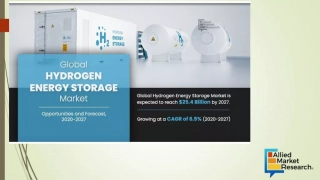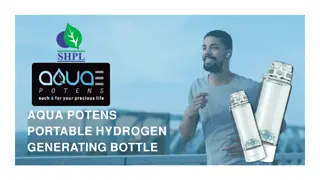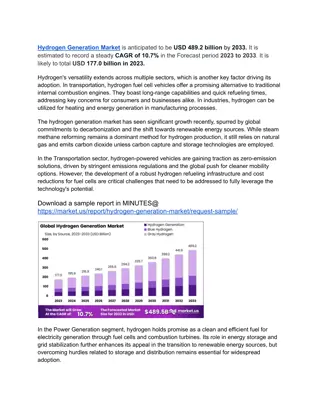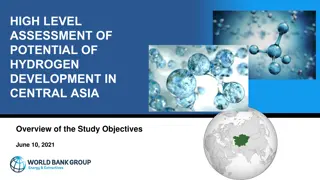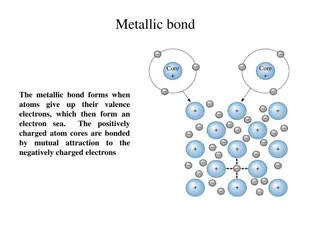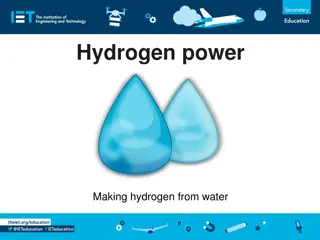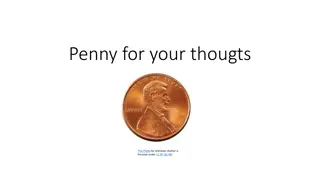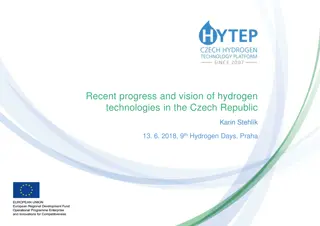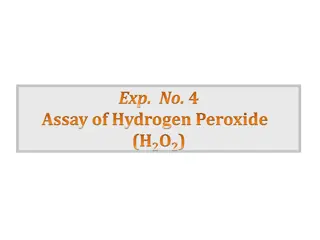Understanding the Unique Properties of Water: Adhesion, Cohesion, and Hydrogen Bonds
Explore the fascinating properties of water molecules, including adhesion, cohesion, and hydrogen bonding, and their significance in nature and life on Earth. Learn how these properties contribute to various phenomena and understand the formation of hydrogen bonds in water molecules.
Download Presentation

Please find below an Image/Link to download the presentation.
The content on the website is provided AS IS for your information and personal use only. It may not be sold, licensed, or shared on other websites without obtaining consent from the author. Download presentation by click this link. If you encounter any issues during the download, it is possible that the publisher has removed the file from their server.
E N D
Presentation Transcript
Properties of Water Fall 2012
Goals Students will 1. Observe and describe phenomena related to adhesion and cohesion of water 2. Interpret evidence of adhesion and cohesion to infer how the water molecule behaves 3. Make connections to other applications of adhesion and cohesion
OLPs Addressed Principle 1: The earth has one big ocean with many features Most of Earth s water (97%) is in the ocean. Seawater has unique properties: it is saline its freezing point is slightly lower than fresh water its density is slightly higher its electrical conductivity is much higher it is slightly basic
OLP #1 (cont.) The salt in seawater comes from eroding land, volcanic emissions, reactions at the seafloor, and atmospheric deposition. (OLP 1e)
Adhesion and Cohesion Adhesion and cohesion are two properties of water molecules that make water particularly unique. These properties have many implications for life on earth. For any pure substance, cohesion is the tendency of molecules of that substance to be attracted to each other adhesion is the tendency of molecules of one substance to be attracted to molecules of another substance
Water Water is particularly cohesive. Water is also quite adhesive to many different substances. Cohesion and adhesion of water are often found acting in tandem in nature. Water is able to wick its way up a paper towel because the water molecules are attracted to the paper material (adhesion) and as water molecules travel up the paper towel, they pull other water molecules along with them (cohesion).
Hydrogen Bonds The extraordinary cohesive and adhesive properties of the water molecule are due to hydrogen bonding. Hydrogen bonds are one type of force that acts between molecules, called an intermolecular force. Unlike true bonds (intramolecular forces), which hold together atoms within molecules or ionic networks, intermolecular forces like hydrogen bonds are forces of attraction between molecules.
Formation of Hydrogen bonds Hydrogen bonds are able to form when hydrogen atoms are covalently (intramolecularly) bonded to either nitrogen (N), oxygen (O), or fluorine (F) atoms. Due to the large difference in electronegativity between H and the elements N, O, and F, a small separation of charge occurs in the covalent compounds, leaving hydrogen with a partial positive charge and N, O, or F with a partial negative charge.
Hydrogen bonds (cont.) The partially charged atoms within the molecules are then attracted to partially charged atoms of other molecules, allowing the formation of hydrogen bonds between the molecules (intermolecular). While hydrogen bonds are not true bonds, they are very strong intermolecular forces (T- CA Fig 3.2)
Hydrogen bonding in water T-CA Fig 3.2. Hydrogen bonds are represented as dashes between molecules. Covalent bonds are represented as solid lines within molecules. Partial charges are represented by . Each water molecule can form up to three hydrogen bonds.
Activity: Properties of Water Part A *START A NEW PAGE IN YOUR SNB! *WORK IN PAIRS! A. How many drops of water can you fit on the surface of a penny without the water spilling over? 1. Predict how many drops of water will fit on a penny. Record your prediction.
Activity: Properties of Water Part A 2. Use the plastic pipette to drop water on the surface of a penny. Drop carefully and slowly to fit as many drops as possible on the penny. Count each drop until the water spills over the side of the penny and record your results. 3. Compare your results to those of your classmates. Record the range and calculate the average number of drops that fit on a penny. 4. Add more drops to the penny, without letting the water spill over. Carefully observe and draw the water on the penny.
Activity: Properties of Water Part A 5. Invent and record a hypothesis for the behavior of water that you observed, using the language of cohesion and adhesion in relation to the water and the penny.
Properties of Water Part B B. Can you prod the water on the penny without spilling it? 1. Add drops of water to the penny, until the water is almost ready to spill over. 2. Predict what will happen when you insert a skewer or toothpick into the surface of the water piled on the penny. Record your prediction.
Properties of Water Part B 3. Insert the skewer and carefully observe the surface of the water. 4. Try inserting the skewer in various ways. Observe the surface of the water. Pay special attention to the water surface where the skewer enters the water. 5. Record your observations and draw what you see.
Properties of Water Part B 6. Repeat procedures B1-B5 using a paper clip and the metal clip part of a binder clip. Try to indent the pile of water as much as possible without spilling it. 7. Record your observations and draw what you see, paying careful attention to the surface of the water. 8. Invent and record a hypothesis for the behavior of water that you observed using the language of cohesion and adhesion in relation to the skewer, the paperclip, the binder clip, and the water.
More on Hydrogen Bonds Hydrogen bonds form when hydrogen atoms covalently bonded to nitrogen (N), oxygen (O), or fluorine (F) in the form of covalent compounds such as: ammonia (NH3) water (H2O) hydrogen fluoride gas (HF)
Hydrogen bonds in molecules In these molecules, the hydrogen atoms do not pull as strongly on the shared electrons as the N, O, or F atoms. Therefore, the molecules are polar the hydrogen atoms become positively charged can form hydrogen bonds to negative ions or negatively charged parts of other molecules (such as the N, O, and F atoms that become negatively charged in these compounds)
Cohesion Molecules of pure substances are attracted to themselves This sticking together of like substances is called cohesion Depending on how attracted molecules of the same substance are to one another, the substance will be more or less cohesive Hydrogen bonds cause water to be exceptionally attracted to each other Therefore, water is very cohesive
Evidence of waters cohesiveness We see evidence every day in water drops and in streams of water Our experience with water, however usually involves water touching something else or being acted upon by gravity. To really get a sense of water s cohesiveness, scientists looked at the behavior of water in space (see Fig. 3-8).
Fig. 3-8 Water drops in space In space, water is able to form perfectly round spheres because the attraction of water to itself pulls the water into the shape with the least amount of surface area compared to the volume a sphere. Fig. 3-8: (b) A large water sphere made on a 5 cm diameter wire loop by U.S. astronaut Dr. Pettit.
Adhesion involves unlike (i.e. different) substances sticking together. Water is very adhesive; it sticks well to a variety of different substances. Water sticks to other things for the same reason it sticks to itself because it is polar so it is attracted to substances that have charges.
Adhesion of Water Water adheres to many things it sticks to plants, it sticks to dishes, and it sticks to your eyebrows when you sweat. In each of these cases water adheres to or wets something because of adhesion. This is why your hair stays wet after you shower. Molecules of water are actually sticking to your hair Adhesion also explains why soil is able to hold water (and form mud).
Fig. 3-9 Child with wet hair http://w ww.flickr. com/pho tos/mori za/28781 11422/ Photo courtesy of Mo Riza
Surface Tension The cohesion of water creates surface tension where air and water meet. We observed this in Activity 2 looked at the ability of water to pile on top of a penny without spilling over (see Fig. 3-11).


